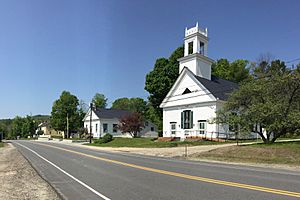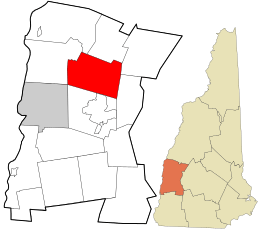Croydon, New Hampshire facts for kids
Quick facts for kids
Croydon, New Hampshire
|
|
|---|---|

Croydon town center: Town Hall on left, First Congregational Church on right
|
|

Location in Sullivan County and the state of New Hampshire.
|
|
| Country | United States |
| State | New Hampshire |
| County | Sullivan |
| Incorporated | 1763 |
| Villages |
|
| Area | |
| • Total | 37.5 sq mi (97.2 km2) |
| • Land | 36.8 sq mi (95.2 km2) |
| • Water | 0.8 sq mi (2.0 km2) 2.07% |
| Elevation | 892 ft (272 m) |
| Population
(2020)
|
|
| • Total | 801 |
| • Density | 22/sq mi (8.4/km2) |
| Time zone | UTC-5 (Eastern) |
| • Summer (DST) | UTC-4 (Eastern) |
| ZIP code |
03773
|
| Area code(s) | 603 |
| FIPS code | 33-16340 |
| GNIS feature ID | 0873572 |
Croydon is a small town in Sullivan County, New Hampshire, United States. It is a quiet place with a friendly community. In 2020, about 801 people lived there.
Contents
History of Croydon
When Croydon Was Founded
Croydon became an official town in 1763. It was named after a place called Croydon, which is a suburb of London, England.
Famous People and Stories
In the 1800s, a powerful politician named Ruel Durkee lived in Croydon. He was known for being very influential in the state's politics.
Croydon was even featured in a popular book! The town of "Coniston" in the 1906 novel of the same name was based on Croydon. The book was written by an American author named Winston Churchill. In the story, Ruel Durkee was shown as a character named "Jethro Bass."
Today, you can still see the influence of this novel. The local Coniston General Store, YMCA Camp Coniston, and Lake Coniston are all named after the book.
Geography and Nature
Where is Croydon Located?
Croydon covers a total area of about 97.2 square kilometers (about 37.5 square miles). Most of this area, about 95.2 square kilometers, is land. The rest, about 2.0 square kilometers, is water.
Mountains and Rivers
The highest point in Croydon is Croydon Peak. It stands about 841 meters (2,760 feet) above sea level. This means it's quite high up!
The North Branch Sugar River flows through the eastern-central part of the town. All the water in Croydon eventually flows into the Connecticut River. This area is part of the Connecticut River watershed, which is like a big bowl where all the rain and melted snow collect and drain into one river system.
Corbin Park: A Special Reserve
Croydon is home to Corbin Park, which is one of the largest private game reserves in New England. It's a huge area, about 24,000 acres, and it's completely fenced in.
Inside Corbin Park, you can find different animals. These include bison, European boar, and elk. The park's woodlands and mountains also stretch into nearby towns.
Neighboring Towns
Croydon shares its borders with several other towns:
- Grantham (to the north)
- Springfield (to the northeast)
- Sunapee (to the east)
- Newport (to the south)
- Cornish (to the west)
- Plainfield (to the northwest)
Population Over Time
| Historical population | |||
|---|---|---|---|
| Census | Pop. | %± | |
| 1790 | 537 | — | |
| 1800 | 984 | 83.2% | |
| 1810 | 864 | −12.2% | |
| 1820 | 1,060 | 22.7% | |
| 1830 | 1,057 | −0.3% | |
| 1840 | 956 | −9.6% | |
| 1850 | 861 | −9.9% | |
| 1860 | 755 | −12.3% | |
| 1870 | 652 | −13.6% | |
| 1880 | 608 | −6.7% | |
| 1890 | 512 | −15.8% | |
| 1900 | 372 | −27.3% | |
| 1910 | 324 | −12.9% | |
| 1920 | 230 | −29.0% | |
| 1930 | 269 | 17.0% | |
| 1940 | 312 | 16.0% | |
| 1950 | 349 | 11.9% | |
| 1960 | 312 | −10.6% | |
| 1970 | 396 | 26.9% | |
| 1980 | 457 | 15.4% | |
| 1990 | 627 | 37.2% | |
| 2000 | 661 | 5.4% | |
| 2010 | 764 | 15.6% | |
| 2020 | 801 | 4.8% | |
| U.S. Decennial Census | |||
The population of Croydon has changed a lot over the years. In 1790, there were 537 people. The population grew to over 1,000 in the early 1800s. Then, it slowly decreased for many years.
By 1920, only 230 people lived in Croydon. But since then, the population has been growing again. In 2020, 801 people called Croydon home.
Notable People from Croydon
Many interesting people have connections to Croydon:
- Augusta Cooper Bristol (1835–1910), a poet and lecturer.
- Jonas Cutting (1800–1876), who became a justice on the Maine Supreme Judicial Court.
- Wallace L. Dow (1844–1911), a well-known architect.
- Whitman G. Ferrin (1818–1896), an attorney and politician.
- Samuel Read Hall (1795–1877), an important educator.
- Gershom Powers (1789–1831), who served as a United States representative.
- Baron Stow (1801–1869), a respected Baptist minister.
See also
 You can also find this article in Spanish: Croydon (Nuevo Hampshire) para niños
You can also find this article in Spanish: Croydon (Nuevo Hampshire) para niños

